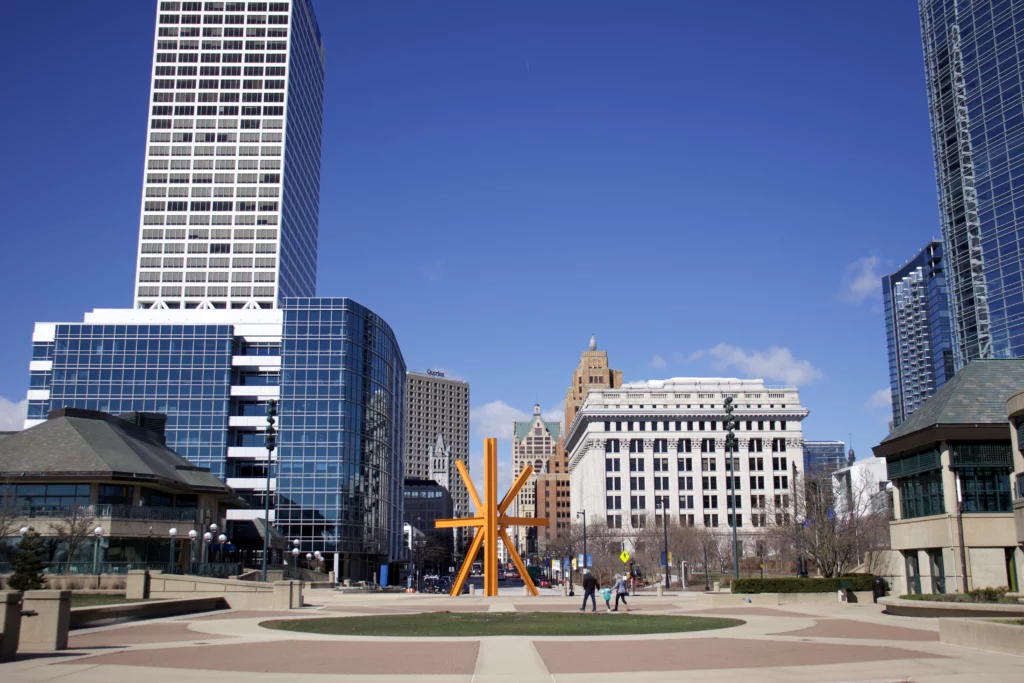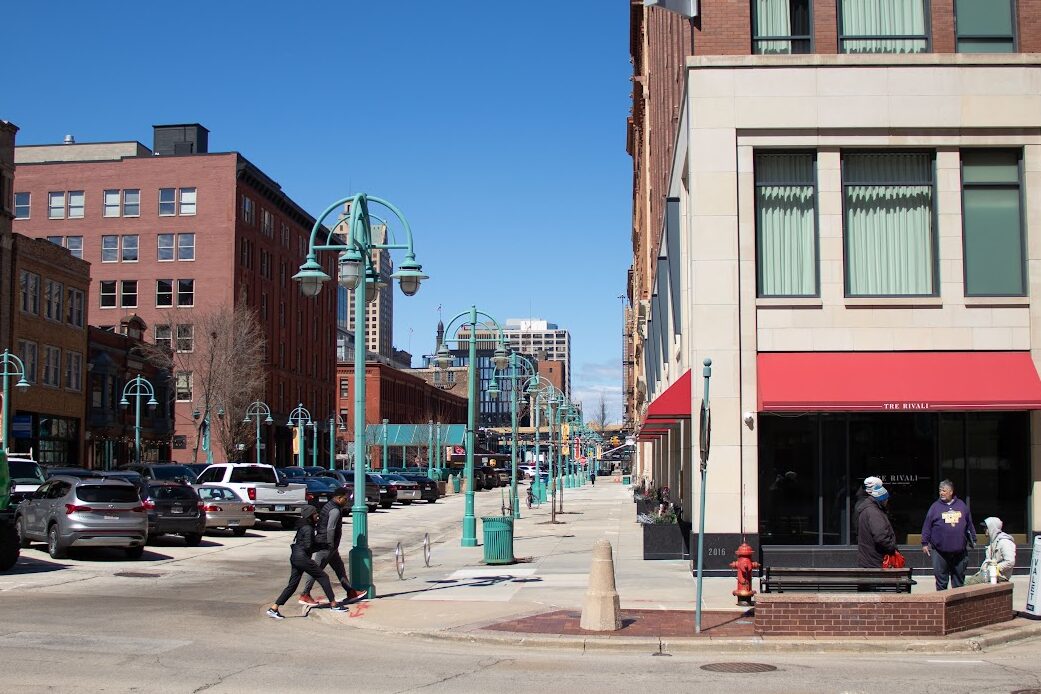Midwest cities are rethinking their allegiance to the car, and instead embracing people-first development

One year ago, Lauren Kollauf welcomed her first born son into the world. In July, she returned from maternity leave to her role as Executive Director of non-profit The Avenues of Ingersoll & Grand in Des Moines, Iowa. She felt like she was losing her mind. Her to-do list kept growing. She was feeling the pressure of getting back into the swing of things.
But, one day, when she chose to walk to work, Kollauf witnessed a small, yet gratifying moment. It was just two people sitting outside, but it was much more than that. Seeing neighbors utilizing the outdoor seating options in front of the long-standing business Zanzibar Coffee Adventure, just connecting over a cup of coffee, it moved Kollauf to capture the moment and share it online. She’d helped put that seating there. She’d helped make that moment happen.
As part of the organization’s Ingersoll Streetscape Project, implementing pedestrian zones for outdoor seating was a necessity for this commercial district. So was adding ample room to spread out along the sidewalk. Seeing it get utilized was just what Kollauf needed.
“This scene made me so happy,” Kollauf says. “Creating streetscapes creates opportunities for people to interact with each other more often like this in casual ways.”
The Avenues of Ingersoll & Grand oversees the function of the residential and commercial district of Ingersoll and Grand Avenue, working closely with the City of Des Moines. Over the past two decades, they’ve maximized Ingersoll Avenue. They created a multi-modal street equipped with wide sidewalks, designated bike lanes, and frequent bus stops along the 1.5 mile corridor. The Ingersoll Streetscape Project aims to optimize the district in making it more accessible and livable for visitors.

A major benefit of their people-first development is the social connectivity that comes with it. The convenience of one’s car is, well, convenient. Hopping behind the wheel and driving from point A to point B is a no-brainer for many–but we can miss out on so much. That’s why we need walkable cities.
For Lauren Kollauf, one of the most rewarding parts of her work is simply seeing neighbors and community members connecting with one another. As the Executive Director, she’s the leading woman in managing all of the organizations’ efforts. As a result, she works closely with the City of Des Moines and her board members to create a truly livable community with an abundance of amenities for residents, business owners, and community members alike.
Fostering Livability
The Avenues began in 1998 under the name “Restoration Ingersoll.” A small group of concerned residents saw the potential in the district and worked together to brainstorm ways to enhance the area and make it more livable. So in 2004, they piloted what is now the Streetscape Project—with the help of a world-renowned landscape architect, Douglass Hoerr. In this original plan, they raised money for wider sidewalks, plants, and benches on just three blocks.
“The goal was just to create a more inviting atmosphere so that people would want to walk…or want to bike in the neighborhood,” Kollauf says. “To slow them down so they would look at the shops and want to stop.”
Dan Burden is the Director of Innovation & Inspiration for Blue Zones LLC, an organization that works to transform communities worldwide through walkable and bikeable strategies. He was recently named in the Top 100 Influential Urbanists of All Time, and is regarded as a pioneer and champion for walkable communities.
“Livability in communities means that [it] gives you all the opportunity to live a full quality life,” Burden says. “In an absolute high walkability and livability neighborhood, you wouldn’t even need a car, you would be able to give it up completely.”
With more than 40 years of experience, Burden has worked on roughly 3,800 projects in North America alone. He has also done work overseas in New Zealand, Dubai, England, and Australia, where he discovered the value of walkability among Aussies. Burden was able to take knowledge and inspiration from how livable communities function across the pond.
His work transpired through his genuine interest in bikeable communities. He has no degree in urban planning or design; he simply wanted to get more people to bike. From there, Burden became Florida’s first State Bicycle and Pedestrian Coordinator.
“It was really a curiosity I had of how people could stay more active and be able to just pick whatever way they wanted to get around and not have to get into a car,” Burden says.
A 2023 study in Dublin, Ireland, found direct and indirect links between the walkability of a city and happiness of people within it. Walkable communities enable social interactions, which increase resident satisfaction within their neighborhood. Additionally, living in an area that is within walking distance of all of one’s basic wants and needs, such as grocery stores, parks, shopping centers, and schools, provides residents with a sense of security and contentment.
Kollauf lives in the North of Grand neighborhood with access to her favorite restaurants, shops, and doctor’s office within just a few blocks of her home.
“The neighborhood and the community, which I live in is truly livable, I don’t have to go very far to get all of my needs met,” Kollauf says.
People-first developments cannot be attained without the people
Walkable communities reap a number of benefits, so why aren’t all communities walkable? Today, many urban planners and government officials are realizing their value and actively pursuing smarter strategies to get there.
Kyle Gast, an urban planner for the City of Milwaukee, has been a project manager for 15 years. He has been part of two Milwaukee initiatives to optimize the downtown through accessible and sustainable actions. Today, the city of Milwaukee is working to be the “Most Walkable Town in the Midwest” by 2040 through the ConnecingMKE: Downtown Plan.

In 2010, a similar plan was adopted in Milwaukee, which today’s plan has built upon. The plan suggests putting an emphasis on transportation and mobility, sustainability and resilience, housing, public spaces, and more. In order to achieve these goals, however, a high level of public engagement is needed. Milwaukee urban planners and city officials created the Community Council to directly engage with residents and identify the areas of concern.
Gast emphasizes that downtown Milwaukee is “everybody’s downtown.” Public engagement and involvement is of value to the leaders who develop these plans.
Similarly, Burden encourages community input. He seeks out public approval in the developmental stages of a project by laying out his plan and educating the areas’ residents of the impact his proposed changes will have on their community.
If a resident or business owner does not agree with the developments proposed, Burden will not advance the project. He wants community members to feel empowered by their choice to transform their community.
“We have to help people come to understand what their opportunities are,” Burden says. “And once we have a neighborhood that totally gets that, then we can move forward and get the city to go ahead and make the change.”
In recent years, the Ingersoll Streetscape Project has received mixed reviews from residents and business owners. In order to make room for the multimodal design to accommodate pedestrians, cyclists, and motorists, the district has to sacrifice parking spaces, which has posed a stark challenge.
“Even though we have tried to educate [residents and businesses] about all the benefits that the district is gaining from this streetscape, some people are still very hung up on the small negatives, loss of parking being one of them,” Kollauf says.
Most cities are built for motorists, but the reality is that motorists aren’t the only travelers to consider in urban design, which is becoming more clear to cities nationwide. However, there will always be those who resist change, even if it benefits them.

“Ingersoll is an old corridor,” Kollauf says. “It’s been a part of the city’s history for a long, long, long, long time. So people remember it a certain way, and they want it to stay a certain way.”
On the other hand, there are people who see the changes made to Ingersoll and want a stake in the game. For example, developers from Minnesota recently proposed building a cooperative living community for older folks looking to settle down in an active area, specifically to be located the Ingersoll and Grand district.
“[The developers] picked the Ingersoll neighborhood, specifically because of what they saw happening here with the walkability, bikeability, the proximity to restaurants, grocery stores, and services.” Kollauf said. “So when projects like that come along, it’s also very rewarding like, ‘Oh, people see the potential here. They want to be a part of it, and they think other people will want to be a part of it, too.”
It’s a matter of give and take to achieve a livable community. While there are naysayers, there are also optimists who see the real value in people-first development. There are a number of cities, big and small, who actively pursue livability to best accommodate the needs of residents and community members.
Walkable communities can bring people together in ways that can only be achieved through a truly livable environment.
